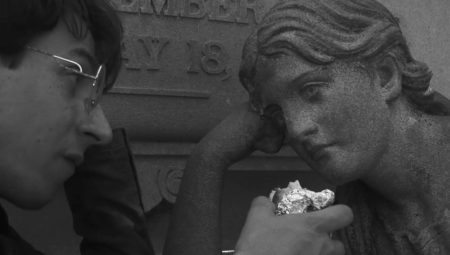
SYNOPSIS:
James Ferrose is a young man who fantasizes about a woman named Jane Matthews and finds himself being bullied by those close to her.
REVIEW:
Like The Catcher in the Rye, the coming-of-age story read by millions, the action in Romeo’s Distress, the new film from director Jeff Frumess, takes place over a period of three days. Unlike in Catcher, there is no Pencey Prep to fail out of, no Ward Stradlater to room with and brawl with, no Mr. Antolini to pat the protagonist on the head in a prelude to a pedophilic moment, and no Jane Gallagher to return phone calls. There is a Jane, though, or more like a Jane Doe: a woman James Ferrose (Anthony Malchar) fantasizes about in his imagination. He’s infatuated with her (Kimberley A. Peterson) and dreams about her in color. His world is in black and white – drab and dull. He’s a graver who carries around a camera and shoots headstones and flowers, pretty much anything that appeals to his sensibilities. He lives with his grandmother, a quiet woman who relies on him for basic needs such as eating, doesn’t have parents or any friends that we are aware of, and lives in a room with a collage of photos of people he admires (William Finley’s turn as the titular Phantom of the Paradise is a nice sub textual directorial flourish). When he isn’t feeding her, he’s singing in the shower in an effort to impress a woman who more than likely is unattainable to him. The images that we see of James and Jane are fun, lighthearted, and adolescent, however we never see them in a truly intimate light.


Unlike most films of the “boy meets girl, boy gets girl, boy loses girl” ilk, Romeo’s Distress showcases a character who is probably just a tad too old to be behaving the way that he is; he may have even found himself in this situation before and just moved on to this new “Jane” much like Terrence Stamp’s Freddie Clegg does after kidnapping Miranda (Samantha Eggar), the object of his affection, in William Wyler’s The Collector (1965) which is a film that, ironically, contains a scene wherein the two characters have a battle of wits discussing the aforementioned Catcher. Catcher and the novel of The Collector, both as literary works, are ultimately about social classes and the differences between people of disparate backgrounds, and the same could be said for James and Jane. The former is average-looking and nebbish not unlike a young Woody Allen and the latter is considerably more attractive than the average wallflower, subtly perpetuating the notion that a woman like her would never go for a guy like him. What’s nice this time around is that the audience isn’t given everything to them on a silver platter. Unlike most films that spell out all of the action, Romeo’s Distress drops visual and verbal cues which gives us an opportunity to think about what it is we are seeing and hearing and get a feel for what is really happening with James.

In one sequence, he reluctantly goes to see a New York City psychiatrist (not cheap) who sternly reminds James that his ongoing treatment is part of his condition of being released from under house arrest. This piques our interest and we begin to wonder if a crime has been committed (considering that Jane is seen only in flashback, it’s not a difficult notion to entertain). In the film’s most lighthearted sequence, James’ Uncle Elmo, played with considerable aplomb by entertainer Dave Street who released a comedy album in 1982 called Is It Okay to Laugh, informs James on how he should seize the day and pursue Jane if he really wants her, confiding in him a similar situation in his own life.

James shows his affection for Jane in a sequence reminiscent of Eric Binford’s lust for Marilyn Monroe in Vernon Zimmerman’s Fade to Black (1980) and tries to buy flowers for her from Seymour the Flowershop Keeper (Stevie Grossett in a spirited performance) in a nice nod to The Little Shop of Horrors (1960). Dressed sharp (cue ZZ Top) in a sports coat with a hat, he is later befriended by a female photographer (Charese Scott-Cooper) in a park whose presence is really a ruse to entrap James into the lair of, presumably, Jane’s father (well-played by the menacing Jeffrey Alan Soloman) and hired cohort Bobby (Adam Stordy) who both torture James to no end in an effort to keep him away from Jane. It isn’t until the film’s end, which is far darker in tone than one would expect, that we see Jason’s true relationship to Jane, the inevitable result of l’amour fou.

Romeo’s Distress was shot on a Canon 70D digital single reflex camera with a two-man crew in New York, New Jersey and Connecticut for 23 days over a 15-month timeframe for $2553.00. For anyone who wants to make a film and feels they don’t have the means to do so, this is proof-positive that it’s possible to do so on a very limited shoe-string. The film benefits from a highly musical score and an award-winning screenplay (the Macabre Faire Film Fest) although it could have used more intercutting and less long-take masters, though on this sort of a budget it’s difficult when using a single camera; a second camera (more money) would have required a third crew member and would have ensured good match cuts provided the action was derived from the same takes.

The film will be screened at the upcoming New Jersey Horror Con and Film Festival which is being held March 31 – April 2, 2017 at the Crowne Plaza Hotel in Edison, NJ. Click here for details.
 Horror News | HNN Official Site | Horror Movies,Trailers, Reviews
Horror News | HNN Official Site | Horror Movies,Trailers, Reviews
